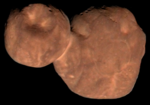毗邻星c
外观
 示意图:毗邻星b和毗邻星c围绕毗邻星的轨道示意图 | |
| 发现[1] | |
|---|---|
| 发现者 | 马里奥·达马索(Mario Damasso)等人 |
| 发现地 | HARPS |
| 发现日期 | January 2020 |
| 迳向速度 | |
| 轨道参数 | |
| 半长轴 | 1.489±0.049 AU[2] |
| 离心率 | 0.04±0.01[3] |
| 轨道周期 | 1928±20 d[3] |
| 轨道倾角 | 133±1[3] |
| 升交点黄经 | 331±1[3] |
| 近心点经度 | −4±4[3] |
| 近心点时间 | 2456202±21[3] |
| 半振幅 | 1.1±0.2[3] |
| 物理特征 | |
| 质量 | 7±1 M🜨[3] |
| 温度 | 39 K(−234.2 °C;−389.5 °F)[1] |
毗邻星c(也称为比邻星c、南门二Cc[2]、或 半人马座αCc),是围绕着最靠近太阳的三合星系统中的红矮星──比邻星的一颗系外行星(比邻星已知有两颗行星,比邻星b和比邻星d)。它位在半人马座,与地球的距离大约4.2光年,是已知最接近太阳系的近地系外行星之一。
性质
[编辑]毗邻星c是一颗超级地球或迷你海王星,质量大约是地球的7倍,大约以1.49天文单位(223,000,000千米) 的距离,每1,928日(5.28年)绕行毗邻星c[3]。如果将毗邻星b类比于地球,那么毗邻星c就是系统中的海王星。由于它距离毗邻星遥远,不在适居带内,平均温度约为39K[1]。
观测史
[编辑]2019年4月,意大利天体物理学家马里奥·达马索和同事首次报告了这颗行星。达马索的团队已经注意到在ESO的高精度径向速度行星搜索器的数据中,毗邻星有轻微的运动,这可能是有第二颗行星环绕着毗邻星[4]。此一发现在2020年1月公布[1]。在2020年6月,利用哈伯太空望远镜在1995年的天体测量数据确认第二颗行星的存在,并得以确定其轨道倾角和真实的质量[3][5]。同样在2020年6月,一项可能检测到毗邻星c的 直接成像被公布。对毗邻星c的质量和年龄的行星而言,检测到的亮度太亮了,这意味着这颗行星可能有一个半径在5 RJ的环[6]。
参见
[编辑]参考资料
[编辑]- ^ 1.0 1.1 1.2 1.3 Damasso, Mario; Del Sordo, Fabio; Anglada-Escudé, Guillem; Giacobbe, Paolo; Sozzetti, Alessandro; Morbidelli, Alessandro; Pojmanski, Grzegorz; Barbato, Domenico; Butler, R. Paul; Jones, Hugh R. A.; Hambsch, Franz-Josef. A low-mass planet candidate orbiting Proxima Centauri at a distance of 1.5 AU. Science Advances. 2020-01-17, 6 (3) [2022-08-19]. Bibcode:2020SciA....6.7467D. ISSN 2375-2548. PMC 6962037
 . PMID 31998838. doi:10.1126/sciadv.aax7467. (原始内容存档于2023-05-21) (英语).
. PMID 31998838. doi:10.1126/sciadv.aax7467. (原始内容存档于2023-05-21) (英语).
- ^ 2.0 2.1 Kervella, Pierre; Arenou, Frédéric; Schneider, Jean. Orbital inclination and mass of the exoplanet candidate Proxima c. Astronomy & Astrophysics. 2020-03, 635. Bibcode:2020A&A...635L..14K. ISSN 0004-6361. arXiv:2003.13106
 . doi:10.1051/0004-6361/202037551.
. doi:10.1051/0004-6361/202037551.
- ^ 3.00 3.01 3.02 3.03 3.04 3.05 3.06 3.07 3.08 3.09 Benedict, G. Fritz; McArthur, Barbara E. A Moving Target—Revising the Mass of Proxima Centauri c. Research Notes of the AAS. 2020-06-16, 4 (6) [2020-08-25]. Bibcode:2020RNAAS...4...86B. ISSN 2515-5172. doi:10.3847/2515-5172/ab9ca9. (原始内容存档于2021-02-28).
- ^ Billings, Lee. A Second Planet May Orbit Earth’s Nearest Neighboring Star. Scientific American. [2022-08-19]. (原始内容存档于2021-01-20) (英语).
- ^ Benedict, Fritz. Texas Astronomer Uses 25-year-old Hubble Data to Confirm Planet Proxima Centauri c. McDonald Observatory. University of Texas. June 2, 2020 [2020-08-25]. (原始内容存档于2020-06-07).
- ^ Gratton, R.; Zurlo, A.; Le Coroller, H.; Damasso, M.; Del Sordo, F.; Langlois, M.; Mesa, D.; Milli, J.; Chauvin, G.; Desidera, S.; Hagelberg, J. Searching for the near-infrared counterpart of Proxima c using multi-epoch high-contrast SPHERE data at VLT. Astronomy & Astrophysics. 2020-06, 638. Bibcode:2020A&A...638A.120G. ISSN 0004-6361. arXiv:2004.06685
 . doi:10.1051/0004-6361/202037594.
. doi:10.1051/0004-6361/202037594.



